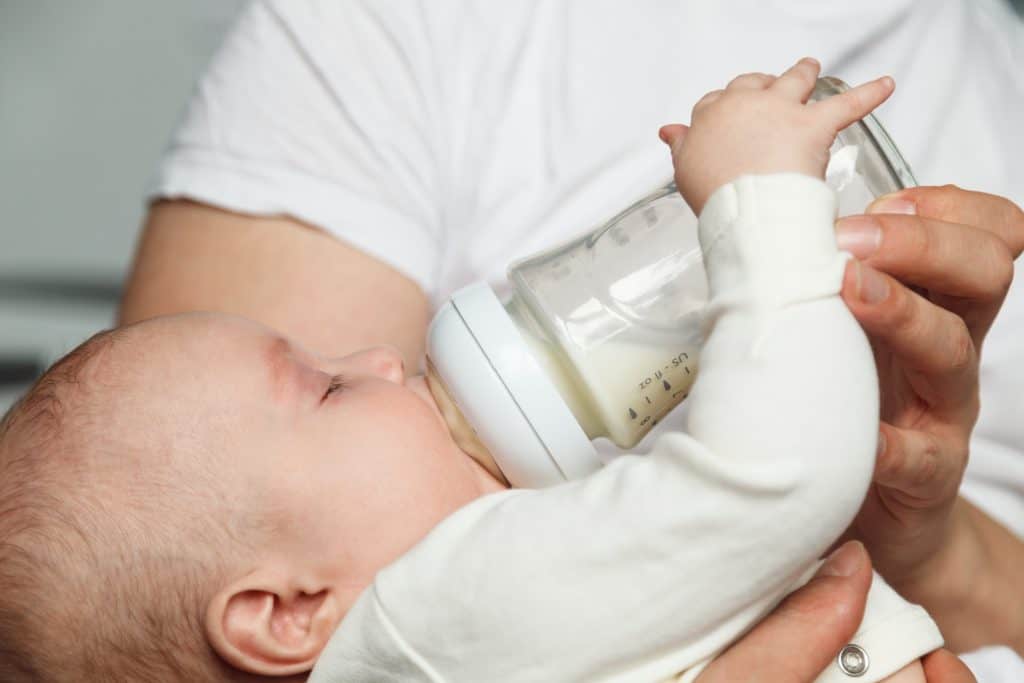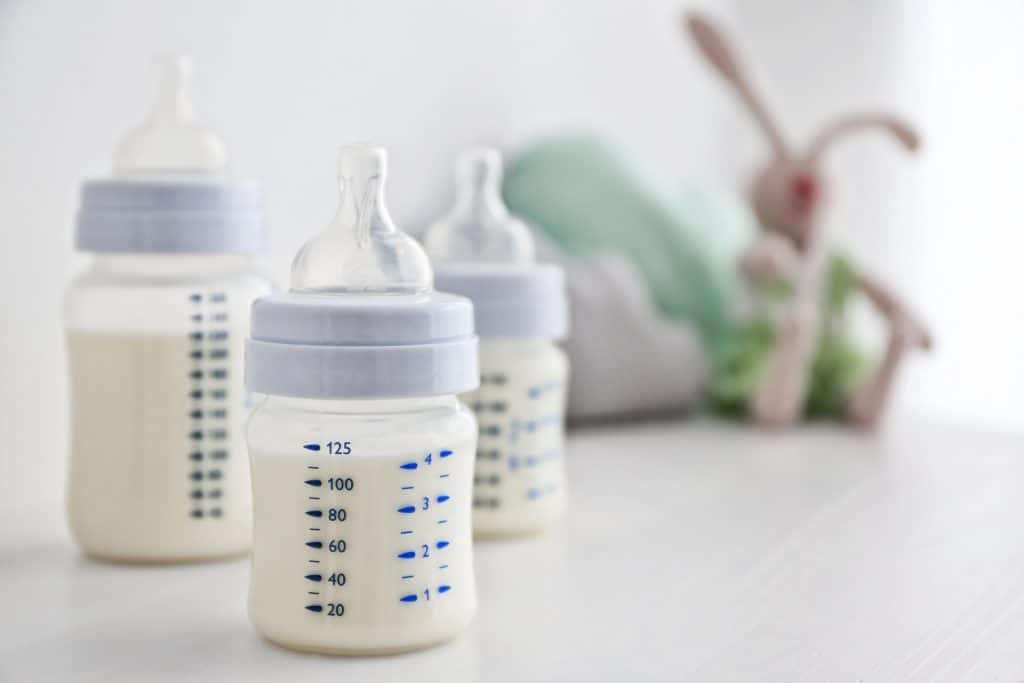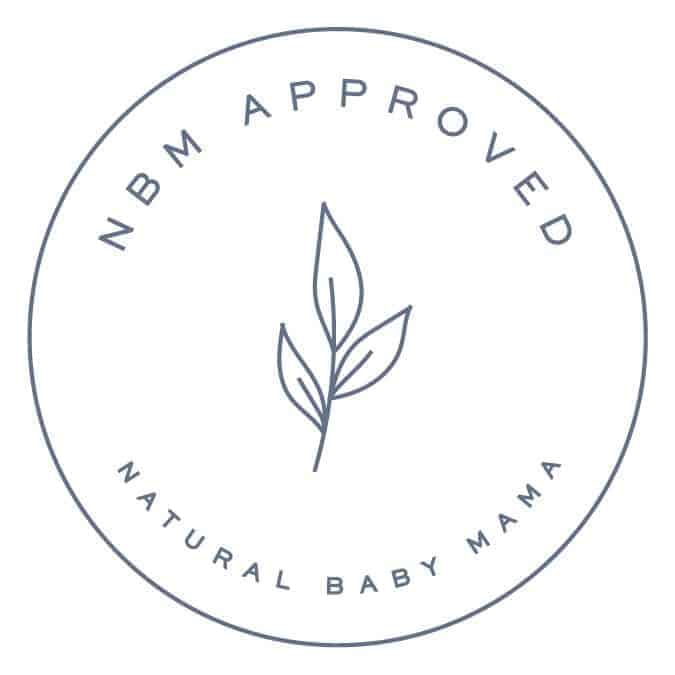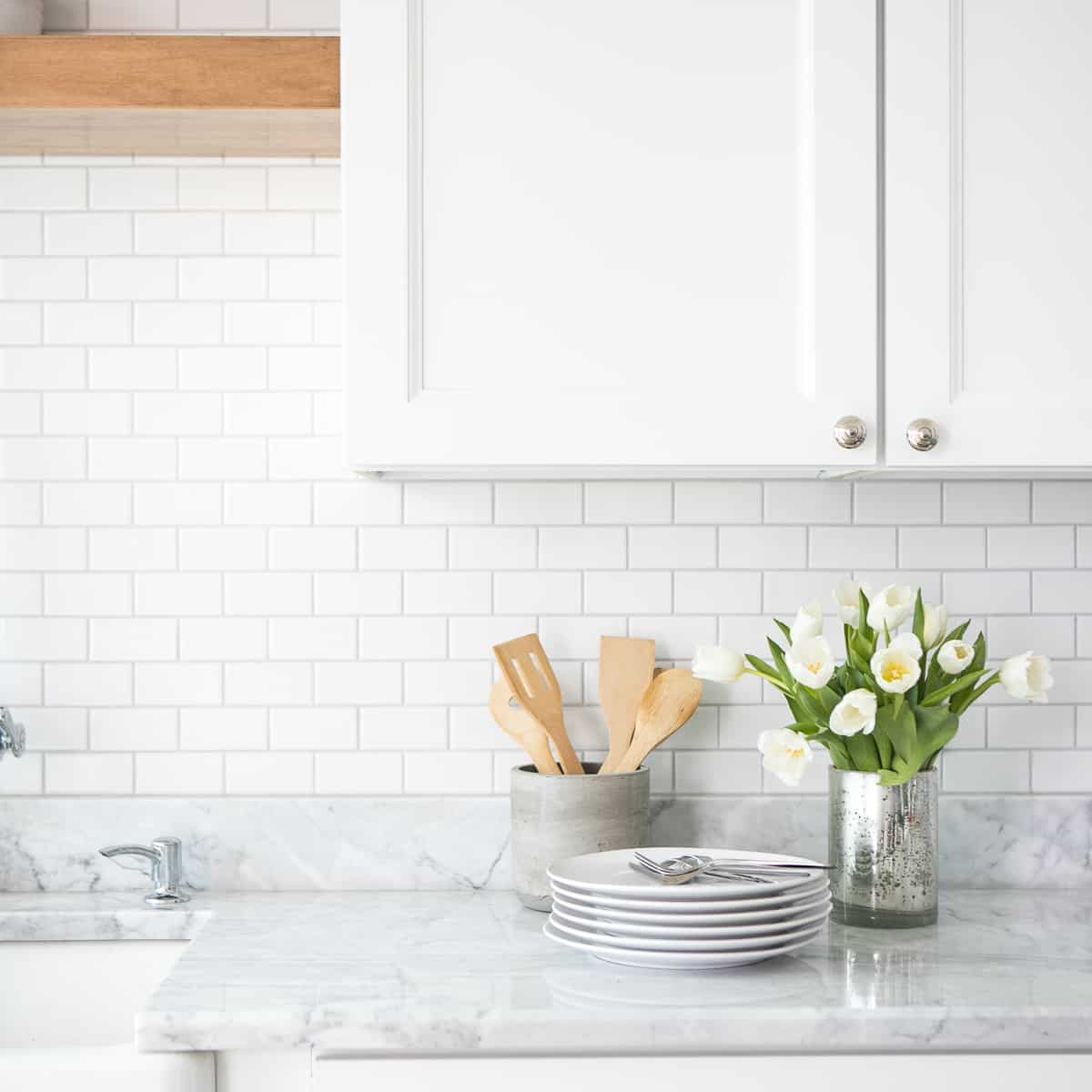As parents, we want the best for our kids, especially when it comes to keeping them healthy. Finding a non-toxic baby bottle at the store can be difficult. Understanding what to look for in a non-toxic baby bottle is the first step to keeping harmful chemicals like BPA or BPS away from your baby.

Once you know what to look for, finding the best non-toxic baby bottle is the next step. I have done the leg work and research for you and have recommendations for the best non-toxic baby bottles.
A recent study at Washington State University discovered the same reproductive mutation in mice exposed to alternative BPA (BPS, BPAF) as those exposed to BPA.
Plastic can also leach at room temperature (and higher) and plastic will break down over time. Because of that, I recommend non-plastic baby bottles.
There are plenty of non-toxic and plastic-free baby bottles on the market. Below you will learn what to look for in a non-toxic baby bottle and the safest options available.
Quick Navigation
What to Look for in a Non-Toxic Baby Bottle
The two safest options for non-toxic baby bottles are glass and stainless steel.
Glass
Glass baby bottles are the safest choice on the market because they don’t leach chemicals at high temperatures or break down over time. Glass baby bottles are truly non-toxic and free of BPA, lead (make sure to look for unpainted), and phthalates.
The two main cons of glass baby bottles include their breakability, and they are heavier.
Stainless Steel
Food-grade stainless steel baby bottles come second to glass baby bottles. Stainless is lighter than glass and won’t break.
However, stainless steel can leach nickel or chromium if acidic liquids are used. If you choose a stainless steel baby bottle, remember to only use non-acidic beverages to avoid leaching.
What about Silicone?
Silicone is safer than plastic but not as safe as glass or stainless steel baby bottles.
Silicone is considered a hybrid rubber-plastic, and the research around its effects on human health is limited. From the research we do have, we know silicone is not fully inert and can leach chemicals. Especially when silicone has been heated and/or in contact with high-fat substances.
With that said, silicone nipples are a safer option than traditional plastic nipples.
With silicone, you always want to look for high-quality food-grade or medical-grade silicone without any fillers.
Toxins Found in Plastic Baby Bottles
BPA, BPS, and microplastics are found in plastic baby bottles. These toxins can cause adverse effects.

BPA and BPS
BPA and BPS are common plastic ingredients and are used in many plastics. BPA will rapidly leach at high temperatures, which is a problem for baby bottles serving warm breast milk or formula. In addition, it has been found that no exposure to BPA is safe, so even drinking cold or room temperature drinks from a BPA bottle still poses a significant risk.
BPA has been found to damage brain development and increases the risk of diseases over time. Infant development is especially sensitive to BPA, which lead Canada to ban BPA in all baby bottles in 2008.
The U.S. National Institute of Environmental Health Sciences’ National Toxicology Program (NTP) discovered exposure to BPA increases mammary and prostate cancer risk. Exposure during pregnancy can decrease the difference between male and female attributes in utero.
BPS was created as a safer alternative to BPA, but its chemical structure is very similar. Since BPS is relatively new to the market, there is limited research available. We do know BPS is a potential endocrine disruptor and could disrupt reproductive systems, especially in young children.
BPS isn’t showing to be safer than BPA, so BPA free doesn’t mean free of toxins.
Microplastics
Microplastics are tiny bits of plastic, so microscopic that you don’t see them. They end up in our waterways and food supply. They have also been found in the liquid contents of plastic baby bottles.
A study from Nature Food found that bottle-fed babies around the world are consuming more than 1.5 million particles of microplastics.
During testing, Nature Food found hundreds of thousands of microplastics were found in baby bottles using room temperature water. Using hot water led to millions of particles being found. The plastic baby bottles also released trillions of tiny nanoplastics.
So is there a concern with ingesting microplastics? Research is still developing but studies have found inflammation in mice and accumulation of plastic in the liver, kidneys, and gut. In addition, there were altered biomarkers showing neurotoxicity as well.
Lead Found in Baby Bottles
Lead is a harmful neurotoxin that causes brain damage, especially in children under six years old. Exposure to lead can also cause issues with the nervous system, developmental delays, speech and hearing problems, and behavioral issues. Even though great strides have been taken to reduce lead exposure in the population, your child could still be exposed to lead.
While doing lead testing with some of my readers, lead was discovered in a popular glass baby bottle. The paint for measurements on the outside of the baby bottle was lead paint. The bottle company has since removed the lead paint and explained it was random luck that lead was found.
Be wary of painted bottles, and make sure to do your research. Because of this experience, I always recommend baby bottles without painted details, but I have included some bottles with paint in the list below because options are limited without them.
While paint can be a concern, etched decorations are completely fine.
What to Look for When Shopping for Non-Toxic Baby Bottles:
- Glass or stainless steel bottle
- Silicone or natural rubber nipple
- No paint or painted markings
- No plastic
Glass Baby Bottles
Pros
- No leaching
- Doesn’t break down over time
- Free of toxins
Cons
- Potentially breakable
- Heavier than other bottles
Stainless Steel Baby Bottles
Pros
- Inert for non-acidic substances
- Not breakable
- Lighter than glass
Cons
- Can leach nickel or chromium if acidic liquids are used
- Heavier than silicone
Silicone Baby Bottles
Pros
- Less toxic than plastic
- Lighter than glass or stainless steel
Cons
- Can leach chemicals at high temperatures
- Can leach chemicals when in contact with high-fat substances (like breast milk and formula)

The Best Non-Toxic Baby Bottle Recommendations

Below are some of the best non-toxic baby bottles on the market. I have personally tested some of these products for heavy metals. They are broken down by category, with glass being the first since glass is the most non-toxic.
* The asterisk means I have personally tested this brand to be free of heavy metals including lead.
This post may contain affiliate links. Please see my full disclosure policy for details.
Glass Baby Bottles
LifeFactory *

I love that LifeFactory‘s design allows the bottle to grow with your child from a baby bottle to a sippy cup and finally, a regular water bottle. This allows maximum use of the bottle.
Lifefactory bottle details:
- Thermal shock resistant borosilicate glass which allows transition safely from freezer to boiling water.
- Medical-grade silicone nipple
- Medical-grade silicone sleeve provides durability as well as an easy grip
- Compatible with most breast pumps
- Made in the US and Europe
You can also use the Dr. Brown’s nipples if you need a different flow.
I have personally tested this bottle to be lead-free. In addition, there is no paint on any of their bottles.
Dr. Brown’s Glass Bottles

Dr. Brown’s bottles are made from non-toxic glass with silicone nipples. They come with a venting system that grows with your baby (the venting system is made of plastic).
Dr. Brown’s bottle details:
- Pharmaceutical-grade borosilicate glass that is heat and thermal shock-resistant (withstanding hot, cold, and gradual temperature changes).
- Anti-colic internal vent system that is clinically proven to decrease spit-up, burping, and gas. The internal vent system is made of polypropylene plastic.
- Silicone nipple
- Silicone sleeves are available separately and on some of their glass bottles for easier grip.
- Dr. Brown’s bottles are made in the US, China, and Germany.
Dr. Brown’s bottles do contain paint. I have not tested their bottles personally but have seen test results over the years and they have been lead-free.
Advent

Advent bottles are also made of glass with silicone nipples. The nipple on this bottle is breast-shaped and aids in easy latching.
Advent details:
- Tempered glass
- Uniquely shaped which make it easier to hold
- FDA food-grade silicone nipple
- Proflo Venting Technology, 1-piece venting system designed to reduce gas, reflux, and colic
- Compatible with most breast pumps
- Made in Mexico
There is no paint on these specific Advent bottles.
Mason Bottle

Mason bottles are a silicone nipple that you can use on your mason jars. This allows you to reuse the mason jar long after the baby bottle days, making this the ultimate low-waste option.
Mason Bottle details:
- Medical-grade silicone nipple with wide breast-like design to support breastfeeding.
- You can use the mason jar aluminum rings, mason bottle’s plastic rings, or my favorite choice the Ecojarz stainless steel rings to secure the silicone nipple to the mason jar.
- Leak-free
- FussFreeTM Ventilation System: dual valve system allows air to be taken in and milk to flow smoothly out with no air bubbles to help prevent gas and colic.
- Silicone sleeve available for easier grip
- Made in the USA
Discount code: 15% off using code naturalbabymama on their website.
I have personally tested mason jars to be lead-free.
Buy Mason Bottles on their website or on Amazon
Evenflo

Evenflo bottles are made with tempered glass and silicone nipples. They come with a simple venting system and molded measurement markings.
Evenflo details:
- Tempered glass
- Uniquely shaped which make it easier to hold
- FDA food-grade silicone nipple
- Proflo Venting Technology, 1-piece venting system designed to reduce gas, reflux, and colic
- Compatible with most breast pumps
- Made in Mexico
There is no paint on these specific Evenflo bottles.
Stainless Steel Baby Bottles
Pura *

Pura’s bottle grows with your child from a baby bottle, to a sippy cup, to a regular water bottle. This maximizes the length of time you use this bottle.
Pura bottle details:
- Food-grade #304 (18/8) stainless steel
- Medical-grade silicone nipple
- Slow flow nipple with anti-colic vent tube
- Internal etched volume marks for easy measuring
- Silicone sleeve for easier grip
- Insulated baby bottles available
- Made in China
I have had readers test this brand and have received updated independent 3rd party testing from the company in 2020 and this brand is lead-free (including the insulated bottles).
Silicone Baby Bottles
Comotomo

Comotomo makes high quality silicone baby bottles and nipples that are designed with breastfeeding in mind.
Comotomo bottle details:
- Food-grade silicone bottle and nipple
- Non-leaking dual air-vents to prevent colic
- Designed to mimic breastfeeding
- Wide neck design for easy cleaning
- PPSE polymer plastic used on the inner ring clip that holds the bottle together, no plastic comes in contact with liquid. The outer ring and bottle cap is polypropylene (which is considered a safer plastic).
- Made in South Korea
Nipple Recommendations
When looking for silicone nipples, make sure to use food-grade or medical-grade silicone. Another option is natural rubber (if no latex allergies). Avoid synthetic rubber nipples.
Baby Bottle Accessory Recommendations
There are a few accessories that you will need. I like to keep things simple to start and if you need more things as time goes on you can add on then.
Bottle Brush

You will want a good bottle brush. I personally like the OXO bottle brush with the stand. There is a hidden silicone nipple cleaner to get into the small spaces.
Bottle Drying Stand

I love the Boon bottle drying rack. They have stem and twig accessories for holding the small parts. A water tray on the bottom catches the water and is easily washable.
Boon is BPA, PVC, and phthalate free.
Final Thoughts
The safest, non-toxic baby bottles are glass bottles and stainless steel. Silicone is less safe than glass or stainless steel but much safer than plastic.
There are so many great non-toxic baby bottle options, I am sure you will find one that works for your family.
It can be overwhelming to find truly safe products. I have created the Natural Baby Mama Amazon Storefront for vetted non-toxic products for you and your baby – make sure to check it out!
Pin it for later!

Other Related to Posts to Non-Toxic Baby Bottles:
- Goat Milk Formula
- Kid’s Certified Organic Clothes
- Natural Diaper Rash Creams
- Organic Crib Sheets
- Wood Play Gym
- DIY Natural Baby Wipes
- Natural Teethers
- Cloth diapers & my wool cover obsession
- Organic New Born Baby Clothes
- Organic Baby Formula
- How to build a Non Toxic Nursery
Sources:
- Chemical Watch. BPS: safer alternative?
- Scientific American. Consumer Alert: Plastics in Baby Bottles May Pose Health Risk
- CDC. Prevent Children’s Exposure to Lead.
- Life Without Plastic. What is Silicone?




Have the Avent bottles changed? I bought the ones above and they had grey paint on them.